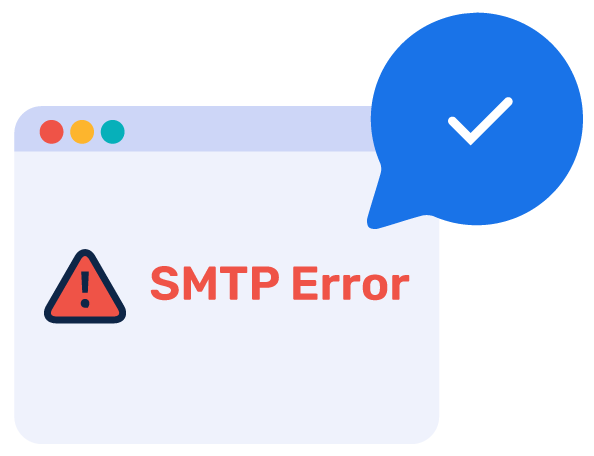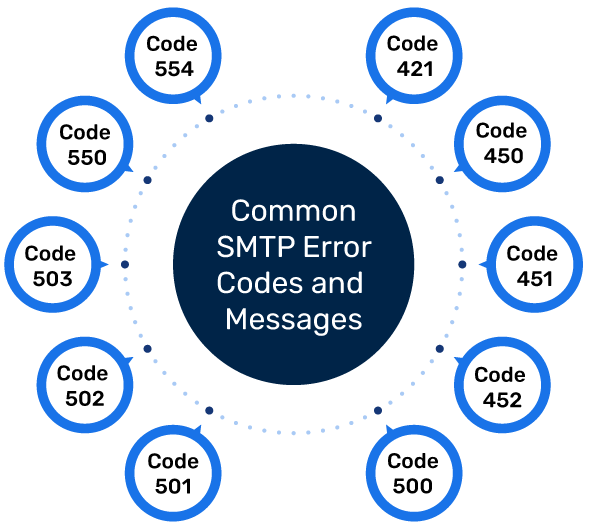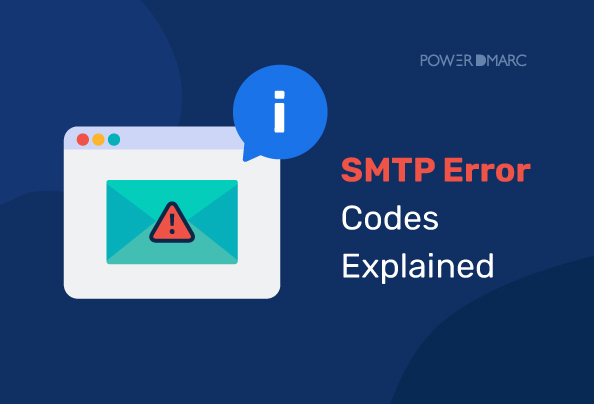If your emails have ever failed to get delivered to their intended inboxes, you may have encountered SMTP error messages. These messages can be of various types and describe the cause of the issue faced during email delivery.
The average email delivery rate, as tested by Email Tool Tester, is around 83 percent is less than 85%!. It signifies that around 16 percent of all the emails fail to reach their destination due to errors.
SMTP errors can prevent the delivery of important emails. These issues must be addressed promptly to emjoy smooth email deliverability, and prevent email marketing backlogs. This guide will explain some of the common SMTP response codes and how the they can potentially be resolved.
Key Takeaways
- SMTP errors can significantly hamper email deliverability, affecting communication and marketing efforts.
- The average email delivery rate is around 83%, which underscores the importance of understanding SMTP issues.
- SMTP error codes are three-digit numbers that help diagnose the reasons behind email delivery failures.
- Common SMTP error codes like 450 and 550 indicate issues with recipient mailboxes or incorrect addresses.
- Resolving SMTP issues may involve checking email addresses, correcting server settings, or employing better email authentication protocols.
About Simple Mail Transfer Protocol (SMTP)

SMTP is an internet protocolstandard named ‘Simple Mail Transfer Protocol’. As an application layer protocol, SMTP It is used to send and receive messages through the serverusing TCP/IP connections. Email has been considered as the most valuable communication system for quite some time. Most internet servers have been using SMTP for the transmission of these emails.
Before sending an email, the client connects to an SMTP server via TCP port 25. The SMTP server receives the connection and after establishing it, lets the user send an email.
Simplify SMTP Error Codes with PowerDMARC!
How SMTP works
SMTP is an electronic mail transfer protocol designed to move a message from one point to another. It operates over the Transmission Control Protocol (TCP). It uses a client-server model to function.
- And email server uses the SMTP model to send a message from an email client to another email server.
- The email server acts as a relay to send the email to the recipient’s inbox.
- The receiving server uses a protocol like IMAP to download the email to the recipient’s box.
Whenever a user clicks “send”, a TCP connection is established to an SMTP server. The server begins the email transfer process using port 25. The client provides the server with the sender’s and recipient’s addresses and the content.
The Mail Transfer Agent checks if the email addresses belong to the same domain or not. If it does, the email is sent correctly. If not, the server uses the DNS to route the email to the correct server.
Understanding SMTP Error Codes

SMTP error codes are usually the 3-digit code that is used by the SMTP server when your email delivery fails. They help understand the reason behind the failure of attempted delivery.
If you own a website, these error codes can significantly impact the normal functioning of your website’s email system. Customers may not be able to contact you if your SMTP server is showing error messages continuously. This can potentially lead to reduced website visibility.
How to Read SMTP Error Codes
An SMTP error code consists of three digits, and here is what they read.
Error code class
The first digit indicates that the server accepted the command. The server tried to fulfill the action but is facing an error. Its value ranges from 1 to 5.
Subject
The second digit in the error code provides details about the type of issue, such as a syntactic problem or connection problem.
Details
The third digit in the error code gives the specific details about the mail transfer status.
Classification of SMTP Error Codes
| Error Codes | Description |
|---|---|
| 100s | The server is in the dialogue with the client and needs to continue processing the request. |
| 200s | The request has been processed. |
| 300s | The client needs to take further steps to complete the request |
| 400s | The client can try again later as there is a problem with the request. |
| 500s | The request is unable to be completed as there is a problem with the server. |
Common SMTP Error Codes and Messages

SMTP error messages could be of various types. These error messages are the explanations of the error codes. They provide explanations about the reasons for the occurrence of the specific code. These could also include suggestions on how to resolve that issue.
Code 101
SMTP code 101 shows that the server is currently unable to establish a connection.
The issue can be resolved by re-checking and correcting the server’s name. It might have been misspelled.
Code 221
The code 221 means that the server is terminating its transmission channel. The message may not be accompanied by any additional closing comments.
In the context of an email session, the message simply means that the emails have been processed, but the session is ending soon.
Code 354
The message with error code 354 might be somewhat cryptic. It often appears as “Start mail input end <CRLF>.<CRLF>.” This is the standard response to the Data command.
It indicates that the server has received the “From” and “To” details of the email and is ready to receive the body message.
Code 421
SMTP code 421 indicates that the service is unavailable. It could be due to a connectivity problem or any other temporary issue with the server.
As the server is not available right now. It could be either from the sender’s side or the receiver’s side. Try sending the email again whenever the server is up and running.
Code 450
Code 450 means that the action requested by the client couldn’t be completed because the user’s mailbox is unavailable. This could be due to various reasons. Damaged mailbox, an offline server, or IP issues.
Make sure that you are using a reliable IP address. If everything is okay from your side, the server will try sending it again after some time.
Code 451
Code 451 indicates that there has been a hiccup in processing the client’s request. It can also be due to connectivity issues from the internet service provider or the relay server that received the mail.
The issue usually occurs if you are sending a lot of emails with a free email service. If the problem persists, reach out to your SMTP provider for assistance.
Code 452
The code 452 indicates the increased traffic on the server. It means that there are too many emails that have been sent or there are too many recipients. Usually, the storage limit of the mailbox is surpassed in this.
To tackle this issue, try sending an email after some time. As the issue is caused by sending too many messages, resending the same message after some time will work.
Code 455
The code states that the server is currently unable to follow the command. This shows that the server cannot handle the specified parameters at the moment.
The user can attempt to retry the operation again after waiting for some time. If the issue persists, it is advisable to contact the administrator of the receiving server.
Code 500
The code 500 indicates that there is a syntax error. It means that the server couldn’t understand the command sent by the client.
The issue might be due to a conflict between the server and any antivirus software from the client’s side. Make sure to carefully follow the instructions given.
Code 501
This error code signifies another syntax error. But this syntax error occurs with the parameters instead of commands. It usually occurs whenever the email address is incorrect.
Check the antivirus settings on the devices to resolve the issue. Also, keep a check on the email address you have entered. It must be correct.
Code 502
Code 502 indicates that the command given by the client has not been implemented yet. It simply means that the particular function or action the user is trying to perform isn’t available on the server.
The user should reach out to the service provider to get information about the unavailability of that command. Get guidance from them and follow their instructions.
Code 503
This code means that the server has encountered a bad sequence of commands. It can also appear as a sign that the server requires email authentication.
Code 541
Error code 541 occurs when the recipient’s address has rejected the user’s message. It may occur if the sent mail is rejected by the receiver’s anti-spam filter.
The solution might be quite simple. Ask the recipient to add your email address to their whitelist or safe sender list. This is how their email server will recognize your email address as authentic and not spam.
Code 550
Code 550 indicates that the email addresses the client is trying to reach doesn’t exist on the receiving end. Sometimes, this error can also occur if the recipient’s server is blocking incoming emails. This might be due to the lack of email authentication protocols like SPF, DKIM and DMARC.
You must enter the correct and authentic email address. If the error persists, reach out to the recipient directly. Make sure you have the correct email address.
Code 552
Like code 452, error code 552 also occurs when the recipient’s mailbox has reached its storage capacity. The code reads as “Requested mail actions aborted, Exceeded storage allocation”.
The issue can be resolved by utilizing less storage space while sending emails. Reduce the size of attachments before sending them, and try sending a smaller message.
Code 553
The code states that the requested action was not taken, and maillbox’s name is invalid. This means that there is incorrect email address in the recipient line.
Review all the email addresses you are sending the emails. Look for errors like extra characters, blank spaces or wrong names causing this issue.
Code 554
It indicates that the transaction has failed. It means that the sending of the email didn’t occur properly. Receiving this error indicates that the receiving email is spam or that the IP address has been blocked.
To address this issue, you should check if the email address or IP has been labeled as spam. Or go for a professional SMTP service.
Final Words
Understanding SMTP error codes not only aids in diagnosing and resolving email delivery issues but also underscores the delicate intricacies of digital communication. These codes, often seen as mere technical jargon, are the silent arbiters of our daily exchanges, ensuring that messages reach their intended destinations. They remind us that even in an age of instant connectivity, there is a complex and robust system at play, silently working to bridge gaps and connect people.

- SPF, DKIM, DMARC: What They Are and Why They Matter - December 23, 2025
- How to Set Up DKIM: Clear Steps You Can Follow Today - December 23, 2025
- How to Set Up SPF Records for Better Email Security - December 23, 2025



